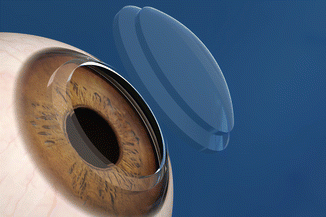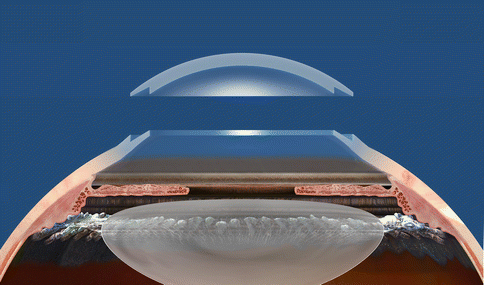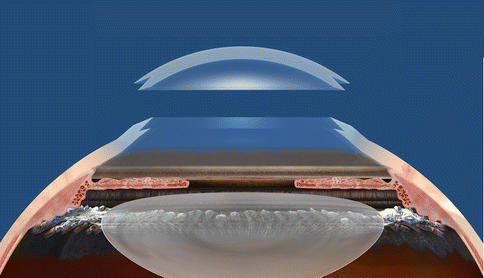Anti-HIV-1, anti-HIV-2 (or combination test)
Hepatitis B surface antigen (HBsAG)
Anti-HCV
Table 11.2
Eye Bank Association of American Medical Standards (EBAA) contraindications for all ocular donors
All ocular donorsa |
|---|
1. Death of unknown cause and there is likelihood of other exclusionary criteria |
2. Congenital rubella |
3. Reyes syndrome within the past 3 months |
4. Active viral encephalitis of unknown origin or progressive encephalopathy (e.g., subacute sclerosing panencephalitis, progressive multifocal leukoencephalopathy, etc.) |
5. Active bacterial or viral meningitis |
6. Active bacterial or fungal endocarditis |
7. Suspected rabies and persons who, within the past 6 months, were bitten by an animal suspected to be infected with rabies |
8. Down syndrome—exclusive for penetrating keratoplasty or anterior lamellar keratoplasty |
9. Intrinsic eye disease: retinoblastoma, malignant tumors of the anterior ocular segment or known adenocarcinoma in the eye of primary or metastatic origin, active ocular or intraocular inflammation,b or congenital or acquired disorders of the eye that would preclude a successful outcome for intended usec |
10. Leukemias |
11. Active disseminated lymphomas |
Table 11.3
Eye Bank Association of American Medical Standards (EBAA) contraindications and criteria for specific procedures
Donors for penetrating keratoplasty (PK) |
1. Prior intraocular anterior segment surgery |
Refractive corneal procedures, e.g., radial keratotomy, lamellar inserts, etc. |
Laser photoablation surgery (these corneas may be used for tectonic grafting and posterior lamellar procedures) |
Corneas from patients with anterior segment (e.g., cataract, intraocular lens, glaucoma filtration surgery) may be used if screened by specular microscopy and meet the eye bank’s endothelial standards |
2. Pterygia or other superficial disorders of the conjunctiva or corneal surface involving the central optical area of the corneal button |
Donors for anterior lamellar keratoplasty procedures or tectonic grafts |
Criteria same as for PK, except that tissue with local eye disease affecting the corneal endothelium or previous ocular surgery that does not compromise the corneal stroma (e.g., donors with a history of endothelial dystrophy or iritis are acceptable) |
Donors for epikeratoplasty procedures |
Criteria same as for PK, except that tissue with local eye disease affecting the corneal endothelium (e.g., donors with a history of endothelial dystrophy or iritis are acceptable). Death to preservation time may be extended |
Donors for endothelial keratoplasty procedures |
Criteria same as for PK, except that tissue with noninfectious anterior pathology that does not affect the posterior stroma and endothelium is acceptable. Surgeons must be notified of any prior pathology prior to placing the tissue for transplant |
Scleral tissue donors |
Criteria same as for PK, except that tissue with local eye disease affecting the cornea is acceptable for use. Death to preservation time may be extended |
Corneal tissue for use of keratolimbal allograft transplantation (KLAL) for severe ocular surface disease (OSD) was described by Holland (1996), who worked with the Minnesota Lions Eye Bank to develop tissue recovery and preparation techniques. These recommendations for tissue procurement and preparation by eye banks were published in 1999, making this advanced surgical technique widely available to surgeons and patients alike (Croasdale et al. 1999).
Full-thickness corneal transplants have been restoring sight for over 100 years (Barraquer 1966). Issues with full-thickness transplants include astigmatism, hyperopic shifts, myopia, suture-induced infection, and loss of the eye from late suture-induced endophthalmitis (Thomas and Purnell 1965). Full thickness cornea transplant wounds can be weak and subject to rupture, even years after the original surgery (Steinberg et al. 2012). The hope of better visual outcomes and a more stable cornea wound led surgeons to investigate replacing only the diseased endothelium of the cornea. Melles, then Terry, showed improved patient outcomes through endothelial keratoplasty (EK) transplants using only the internal 80–200 μm of the cornea, typically prepared by the surgeon during surgery (Melles et al. 1998; Terry 2003). Motivated by the stability of the eye and superior outcomes, surgeons found through endothelial keratoplasty that they could restore and improve more stable vision to patients within 3 months. Surgeons initially prepared their own deep lamellar grafts and evolved to prepare the grafts with a microkeratome (Price and Price 2006). The steep learning curve of graft preparation resulted in perforated and discarded corneas (Glasser 2010). While visual improvement was good news for patients, eye banks could not keep up with the increasing demand and were under more pressure to increase donors to increase available tissue. In 2005, surgeons across the country began to consider the possibility of eye banks preparing their EK grafts, and there was debate for or against non-surgeons doing this technical procedure. However, due to the steep learning curve in preparing the graft, the cost to patients/surgical centers of wasted tissue and the lack of availability of multiple corneas for single surgeries, surgeons were open to the idea of a trained technician taking a cornea that might be 450–550 μm thick and preparing a graft bed of 80–200 μm utilizing a microkeratome. That year, the North Carolina Eye Bank conducted a study demonstrating that eye bank preparation of these grafts did not cause damage to the endothelium (North Carolina Eye Bank 2005).
Although controversial, the advantages of eye bank–prepared tissue began to outweigh the disadvantages. In a retrospective study done at the University of Iowa, eye bank preparation of the tissue saved approximately 25 min of operating room time for the surgeon, the patient, and the surgical facility, as well as reduced the rate of primary graft failure, and improved visual acuity. The study concluded that “Pre-cut donor lenticules are safe and improve OR efficiency” (Silvera et al. 2006). One major advantage was that the surgeon and patient received a graft that was ready to transplant—and the risk of perforation of the cornea was transferred to the eye bank instead of the surgeon. A survey of surgeon satisfaction with precut cornea tissue, conducted by the Iowa Lions Eye Bank in 2006–2007, documented 98 % surgeon satisfaction with eye bank precut tissue. Today, there are some graft preparation eye bank technicians who have prepared thousands of EK grafts, far more than any surgeon could hope to achieve in the same time frame (Kitzmann et al. 2008).
As EK surgery and the request for eye bank–prepared cornea grafts continued to grow, the shortage of corneas also increased, and eye banks began telling surgeons they had no tissue. Not wanting to return to the days of a surgery waiting list, in 2007 about 40 % of US eye banks joined forces through the EBAA’s Cornea Collaborative, a 3-year effort to improve eye banking and, hopefully, improve the cornea supply. Parallel to this effort, a group called “Donate Life America” was working hard to increase organ donation by establishing state registries where people could legally designate their donation wishes before they died. Both the Cornea Collaborative and the Donate Life America efforts have been successful. By 2009 there was no shortage of corneal tissue, and by 2013, with more than 104 million registered donors, Donate Life America continues to promote donation to difficult-to-reach segments of the population (Donate Life America 2013).
With the growth in endothelial keratoplasty, surgeons continued to look for ways to bring improved sight to a greater proportion of their patients. The femtosecond laser had been reliably used in LASIK surgery for years and was adapted to reshape corneal edges in full-thickness transplant surgery. Traditionally, corneal incisions are made with round metal trephines, creating a perpendicular wound. With the femtosecond laser, special-shaped overlapping edges could be created in the patient and the corneal graft. The advantage is a tighter fit of the graft in the eye with fewer sutures required. There are three primary shapes being used: the top hat (Fig. 11.1), mushroom (Fig. 11.2), and the zigzag (Fig. 11.3).




Fig. 11.1
Top hat configuration for femtosecond laser-assisted keratoplasty (Reprinted with permission from Abbot Medical Optics)

Fig. 11.2
Mushroom configuration for femtosecond laser-assisted keratoplasty (Reprinted with permission from Abbot Medical Optics)

Fig. 11.3
Zigzag configuration for femtosecond laser-assisted keratoplasty (Reprinted with permission from Abbot Medical Optics)
This procedure, termed femtosecond laser assisted keratoplasty (FLAK), interlase-assisted keratoplasty (IEK), or femtosecond assisted keratoplasty (FAK) may improve wound integrity and requires that the surgeon and the eye bank use exactly the same cutting parameters on both the donor and recipient tissue (Ignacio et al. 2006; Baradaran-Rafii and Eslani 2013). Use of this technique requires both the surgeon and the eye bank to have access to a femtosecond laser that has been adapted for this type of surgical procedure. Typically, femtosecond lasers used for LASIK must be modified to cut tissue as deep as is required to prepare the patient and the graft for this type of surgery. Today, there are less than a half dozen eye banks that have the equipment required to prepare this graft, and research has not yet verified the superiority of this graft over a traditional PK (Bahar et al. 2009).
The most recent advancement in the evolution of corneal transplant surgery has been Descemet’s membrane endothelial keratoplasty (DMEK). This procedure, including graft preparation, was developed in the Netherlands (Melles et al. 2006), but promptly adopted in the United States due to patients achieving superior visual outcomes in shorter periods of time. Initial graft preparation required that the Descemet’s membrane be separated from the cornea, which is very difficult, and if the tissue tears, the graft is unusable. However, initial outcomes research showing that 75 % of patients attained 20/40 vision or better within a few weeks of surgery was very encouraging (McCAuley et al. 2009; Price et al. 2009). Surgeons all over the world have been working to replicate and improve these results, and eye banks are developing reliable, consistent graft preparation techniques for these very thin grafts. So far, the Submerged Cornea Using Backgrounds Away or SCUBA (Geibel 2010), big bubble technique, a double pass technique (Busin et al. 2012), and a femtosecond laser technique (Iowa Lions Eye Bank) are being developed and studied. Lie et al. described Descemet’s grafts that could be surgically prepared from organ-cultured donor corneas and stored for an additional 3 weeks with acceptable endothelial cell loss (Lie et al. 2008). Studeny described a novel technique for the preparation and transplantation of posterior corneal lamellae consisting of endothelium and bare Descemet’s membrane with a stromal supporting rim (DMEK-S) (Studeny et al. 2010). Recently both Murain et al. and Schlötzer-Schrehardt et al. have described reproducible techniques for DMEK tissue preparations that can be utilized by eye bank technicians (Schlötzer-Schrehardt et al. 2013; Muraine et al. 2013). Eye bank preparation of DMEK grafts saves surgeon time and eliminates the risk of tissue wastage in the operating room.
All U.S. eye banks today are registered with and regulated by the Food and Drug Administration (FDA 2007). Regulation of eye tissue in the United States was not a focus for the FDA prior to the 1990s, when two transplantation events not involving eye tissue commanded the FDA’s attention: First, AIDS-infected transplanted body parts resulted in disease transmission and ultimately death of three patients in 1991. Around the same time, the FDA received reports of tainted foreign tissue being imported into the United States without adequate testing and screening. In response to these serious problems, the FDA promulgated its 1993 interim rule on human tissue intended for transplantation to prevent the introduction, transmission, or spread of communicable diseases through transplantation. They required serological testing (FDA 2007) for HIV and hepatitis, banned imports from other countries unless all FDA requirements were met, and outlined criteria for donor selection. They also included provisions to inspect any establishment at any time and ways to prosecute those that might not allow FDA inspection. Even though ocular tissues were not the problem, they were included as a conventional banked tissue, along with skin and bone.
Stay updated, free articles. Join our Telegram channel

Full access? Get Clinical Tree


